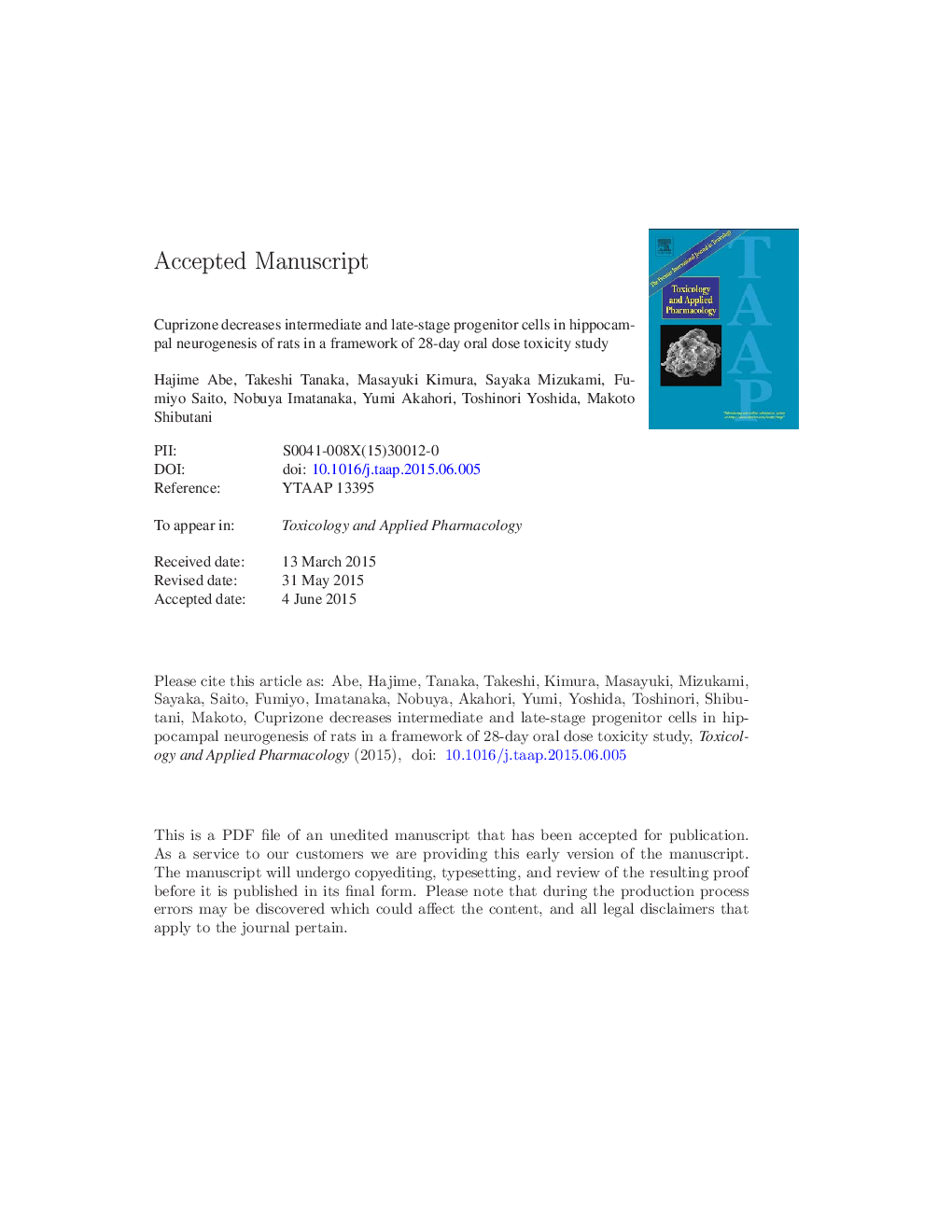| Article ID | Journal | Published Year | Pages | File Type |
|---|---|---|---|---|
| 5845936 | Toxicology and Applied Pharmacology | 2015 | 51 Pages |
Abstract
Developmental exposure to cuprizone (CPZ), a demyelinating agent, impairs intermediate-stage neurogenesis in the hippocampal dentate gyrus of rat offspring. To investigate the possibility of alterations in adult neurogenesis following postpubertal exposure to CPZ in a framework of general toxicity studies, CPZ was orally administered to 5-week-old male rats at 0, 120, or 600 mg/kg body weight/day for 28 days. In the subgranular zone (SGZ), 600 mg/kg CPZ increased the number of cleaved caspase-3+ apoptotic cells. At â¥Â 120 mg/kg, the number of SGZ cells immunoreactive for TBR2, doublecortin, or PCNA was decreased, while that for SOX2 was increased. In the granule cell layer, CPZ at â¥Â 120 mg/kg decreased the number of postmitotic granule cells immunoreactive for NEUN, CHRNA7, ARC or FOS. In the dentate hilus, CPZ at â¥Â 120 mg/kg decreased phosphorylated TRKB+ interneurons, although the number of reelin+ interneurons was unchanged. At 600 mg/kg, mRNA levels of Bdnf and Chrna7 were decreased, while those of Casp4, Casp12 and Trib3 were increased in the dentate gyrus. These data suggest that CPZ in a scheme of 28-day toxicity study causes endoplasmic reticulum stress-mediated apoptosis of granule cell lineages, resulting in aberrations of intermediate neurogenesis and late-stage neurogenesis and following suppression of immediate early gene-mediated neuronal plasticity. Suppression of BDNF signals to interneurons caused by decreased cholinergic signaling may play a role in these effects of CPZ. The effects of postpubertal CPZ on neurogenesis were similar to those observed with developmental exposure, except for the lack of reelin response, which may contribute to a greater decrease in SGZ cells.
Keywords
CHRNA7TrkBTbr2cuprizoneIPCintermediate progenitor cellFOSNG2IBA1SGZBLBPSox2PDGFRACPZHPRT1CALB1calbindin-D-28KCALB2calbindin-D-29KFBJ osteosarcoma oncogeneNTRK2Cholinergic signalingPCNASRY (sex determining region Y)-Box 2Pvalboligodendrocyte lineage transcription factor 2RT-PCRGCLDABOlig2NeuNSSTDcxGFAPOPCMBP3,3-diaminobenzidineBDNFProliferating Cell Nuclear Antigenterminal deoxynucleotidyl transferase-mediated dUTP nick end-labelingtropomyosin receptor kinase BTUNELCNSdoublecortinOligodendrocyte progenitor cellsSomatostatincentral nervous systemendoplasmic reticulumBrain-derived neurotrophic factoractivity-regulated cytoskeleton-associated proteinArcgranule cell layerionized calcium-binding adaptor molecule 1subgranular zoneadult neurogenesisHippocampal dentate gyrusHypoxanthine phosphoribosyltransferase 1reverse transcription-polymerase chain reactionParvalbuminGlial fibrillary acidic proteinbrain lipid binding proteinneuron-specific nuclear proteinMyelin basic proteinthreshold cycleGABAPlatelet-derived growth factor receptor alpha
Related Topics
Life Sciences
Environmental Science
Health, Toxicology and Mutagenesis
Authors
Hajime Abe, Takeshi Tanaka, Masayuki Kimura, Sayaka Mizukami, Fumiyo Saito, Nobuya Imatanaka, Yumi Akahori, Toshinori Yoshida, Makoto Shibutani,
